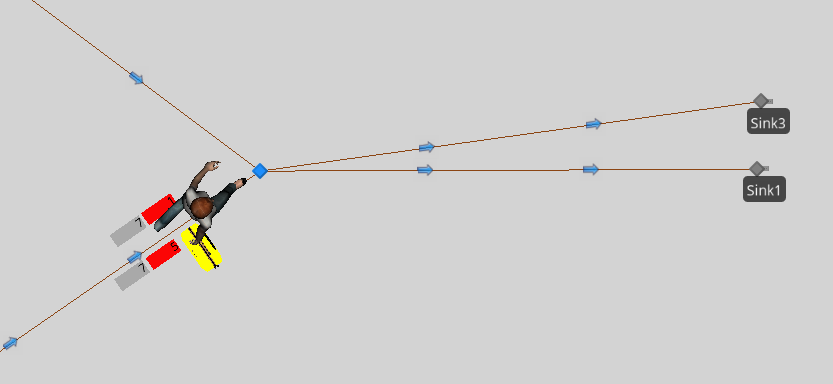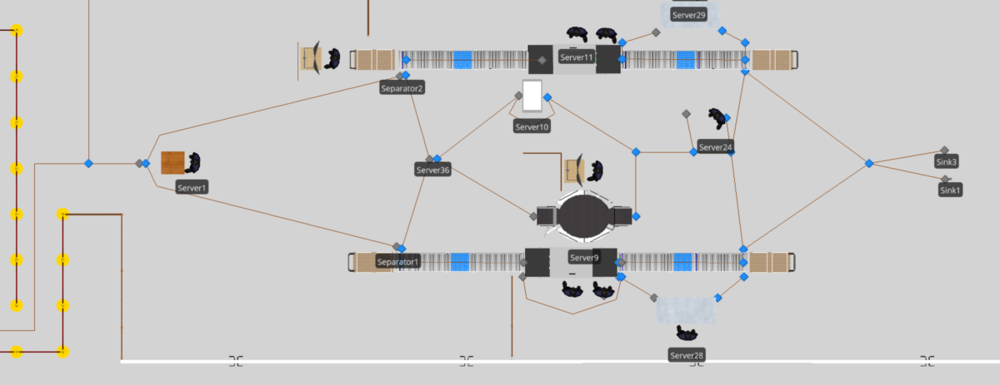Search the Community
Showing results for 'remove parent'.
-
Hi! In my model I have entities called "Pedido" which have a state called "id_del_pedido" which is equal to the ID of the entity. These entities will enter a Separator that will create copies of the entity according to a probability distribution. Since the new entities are copies of the parent entity, they will have the same "id_del_pedido" status as the parent entity. Subsequently, the entities created will enter a Server that acts as a warehouse. This Server is linked to a Combiner, when the parent entity reaches the Combiner's parentinput I want only entities whose "id_del_pedido" is equal to the ID of the entity that reached the Combiner's parentinput to leave the server. This works perfectly in the first Server-Combiner set of my model, but, the Combiner's outputnode is attached to another Combiner and I want to repeat the same activity as in the first Combiner but I get an error that I don't know how to solve. I attach my model so that my problem is better understood. Thank you very much in advance! 18.10.spfx
-
Hello, I have recently encountered an issue while simulating an airport checkpoint and thus leading to the following question: Is it possible to match member and parent priorities under certain conditions? I am trying to differentiate between those travelers (parent entity) and baggage (member entity) going though an additional screening process prior to exiting the model. Take the following image as an example. I managed to provide a priority (red status label) to those entities going through the additional screening while also providing a rule for those with a priority of 5 to exit though Sink 3 (Those with a priority of 1 should exit through Sink1 ). However, the rule seems to only apply to the parent for a reason I assume to be that the baggage is an entity initiated by a "create" step in the processes window, rather than at its own source as the parent. The current rule I have is to decide the following ModelEntity.Priority==5.0, then assigning the desired node (Input@Sink3). In the picture, although the baggage (member) has a priority of 5, the traveler (parent) has a priority of 1 and the rule only applies to the parent. How could I match the priority of the parent, only under the case in which the parent has a higher priority? (Perhaps match the greatest priority of the member and the parent to generalize) I have tried everything possible and I cannot figure it out. Any help is greatly appreciated!
-
Hello, I have been utilizing SIMIO for a couple of months, however I am relatively unfamiliarized with some of the features. I have recently encountered a difficulty while simulating an airport screening checkpoint. Take the attached picture as a reference. I have entities arriving from a single Source, processed initially at Server 1, and then following a series of separators and additional servers along the way. At Separator 1, the member (luggage) is separated from the parent (passenger). (Luggage is created by a "create" step in an add on process, rather than at its own Source). However, I would like to distinguish statistics between those travelers and luggage going twice through a server. For example in Server 10, I have a loop going from the output node to the input node for the re-scanning of passengers. I managed to provide a priority value to the passengers going though that created loop, and an add on process rule to send those with that priority value to Sink 3, while those without the priority value to Sink 1. I tried applying the same concept to the loop seen in Server 9. However, when the passenger picks up the luggage at the transfer node located at end of the conveyor belt, both the member and the parent exit through Sink 1, rather than Sink 3. It appears that only the member obtains the priority, but not the parent. Although I tried, I did not manage to match the priorities and thus have the combined entities exit the model as anticipated. Any thoughts on how I could match the priorities, or perhaps, any suggestions to make this possible? Any help is greatly appreciated!
-
Hi, Is it possible to set the state variable of the parent entity in a batch equal to the sum of state variables of all member entities in the batch? Context of the case; a truck (parent) is loaded with x number of orders (members). These orders have a specific value for the state variable 'NumberOfRollContainers'. The truck has the state variable 'TotalRollContainers', which should equal the sum of the 'NumberOfRollContainers' in that batch. Kind regards, Christa
-
How can I schedule a randomly distributed death event for each entity, and pull them out of the system (or perhaps route to a "mortality" sink) if it occurs before they have already left? Somewhat similar to reneging, but I need mortality to be possible during a service, not only in queues. If an entity is removed from service, I also need the seized resources to be released. What I have tried so far: When an entity is created, I provide them with a state variable for TimeTillDeath, lets say exponential(2) hours. This is a real number, not a datetime. As they enter each queue, I set the reneg trigger as ModelEntity.TimeTillDeath subtract any elapsed time since creation, min 0. This works to model mortality while they are waiting for service, but not during a service. Any help is appreciated, KO
-
Hi guys, I have searched this topic but cannot get a solution to that: is it possible to remove a certain row from a output table? There is a step called "RemoveRows" which removes all rows in the table. What I would like to have is i set a search step first and use the index i found to locate the row in the output table and delete it. Many thanks! Regards Yutong
-
Hello, This model corresponds to an assembly line for three models. ModelA and ModelB are processed from Station1 to Station9 and the leave the line. ModelC must have additional work, which is to be done in Auxiliar (in between Station 8 and Station9), so that it leaves the line after Station 8and gets back to Station9 after the extra operations. A sucbomponent must be ordered in advance to be integrated to ModelC in Auxiliar. The logic I want to implement is the following. I have a list containing all stations (object list lstStations). A list property pointint to that list (rpSynchroStation). For every output node of every station, I want to check if the list property coincides with the name of the corresponding station (and if it's model C in that station). If so, an event is triggered, and a source corresponding to the supplier produces a part that will be delivered some time later. The problem I am having is within the decide step, when comparing: ModelEntity.Location.Parent.Name == rpSynchroStation && ModelEntity.EntityType == ModelC In Decide2 step in procCheckIfSynchro process. I get an error when comparing ModelEntity.Location.Parent.Name == rpSynchroStation. Could you please help me with this? Many thanks Best regards, model_tractors.spfx
-
Doc1.docx I’m having an issue with creating a ParentID state variable. I have an add-on process that when a person is created at the source, bags also get created based on a distribution. This all works well. I got this from a post I put on the Simio forum last year. What I want to do is match my person to bag later on based on a variable ParentID, but no matching happens. I did a trace and see that the bags have a non-zero ParentID, but all the pax have ParentID=0. I assumed that in the Assign step highlighted in the first picture is assigning a ParentID to my person, no? I tried a few things, but get errors in other places. Hints? Thanks.
-
Hello! I have one doubt that I would like to clarify: I have 2 entities that travel grouped (1 is the member and the other the parent). There is one point at my model on which I want to separate them and at the same time copy an array of values from the parent to the member. At the momemt I'm doing this by using a state to hold the information from the parent when he enter the separate and when the member leaves it I copy the values from the state to the member. Untill now everything's fine but I'm a little affraid that it can result in some conflicts when many entities pass through the Separate at the same time... So I would like to know if anybody has any suggestions of how to pass the values directly without a temporarilly state? Just to be clear I'm trying to do something like this: Member.ArrayOfValues[index]=Parent.ArrayOfValues[index] which obviously doesn't work since this process is being executed by a token of the Parent... Thanks!
-
The Combiner object in the standard library assumes that you have a parent entity representing a box or container and members representing the parts that are combined into the parent. In some cases you don't want to have a parent, you just have a number of entities that you want to temporarily join together and process as one. The attached project contains an object of type Node that represents a very simple Combiner and a TestModel to illustrate how it works. The node simply asks for a Batch Size and then holds the incoming entities until that batch size is reached. It creates a "normal" batch so it can be used with the Separator as long as you treat all outbound entities as the same. CombinerNode.spfx Requires Sprint 5.80 or later.



